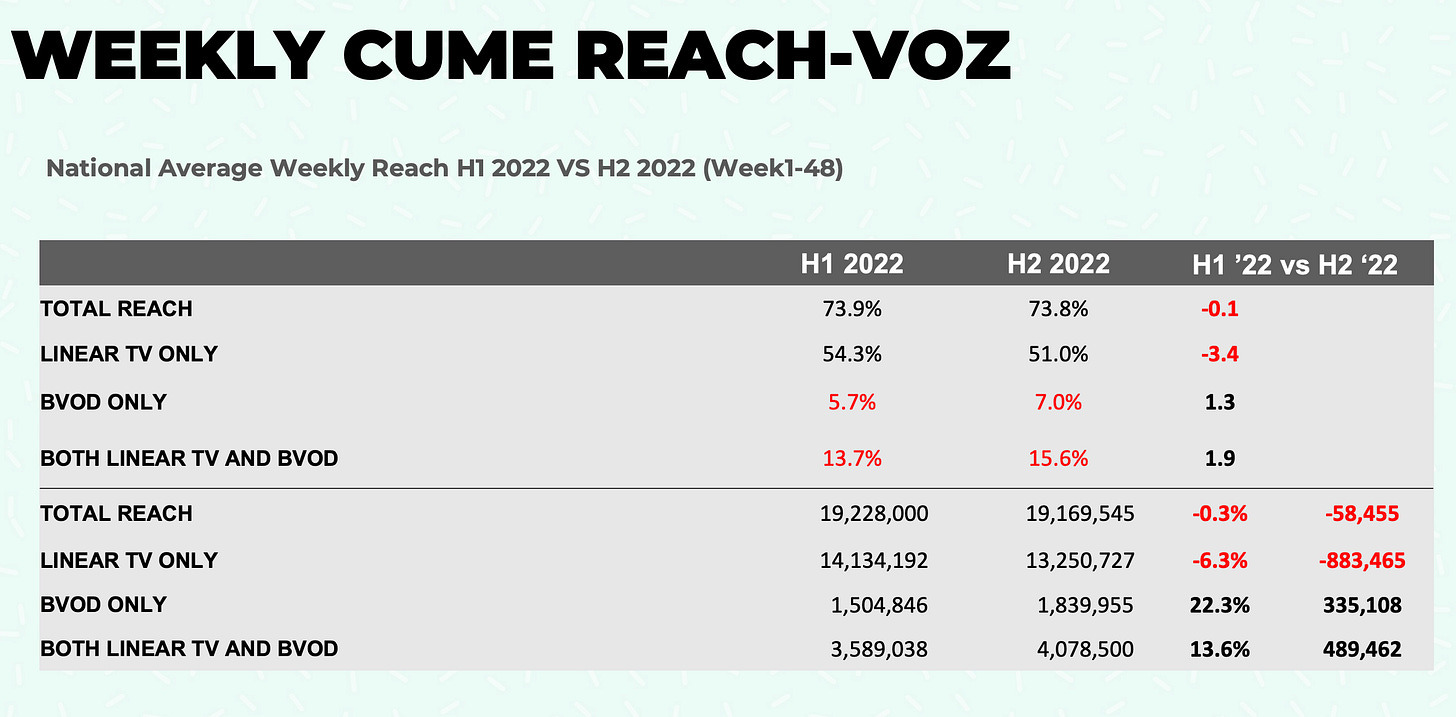Welcome to an audio-led edition of Unmade (plus an update on the Unmade Index further down; market sentiment seems to have turned against media stocks again).
If you’re the sort of person who leaves things to the last moment, then this is your final reminder. RE:Made - Retail Media Unmade is this afternoon. If you’re in Sydney, it’s not quite too late to buy a ticket online, or on the door. Experiencing the indignity of wearing a hand-written lanyard is a sacrifice worth making in order to get on top of a key media trend.
Television at a turning point
TV’s inflection point is coming. Any time now (or maybe it happened in the last few weeks), the proportion of the Australian population who watch television the traditional way will fall below half for the first time.
But as fast as traditional ways of watching are falling, new viewing habits are forming - or that’s what the data in Think TV’s regularly produced Fact Pack suggests.
Analysis of OzTam data for the second half of last year by Think TV suggests that commercial audiences are on the move - from television consumed via their aerials, to video streams.
In today’s Unmade podcast, Tim Burrowes talks to Think TV’s director of research, insights & education Steve Weaver and to the organisation’s CEO Kim Portrate about the meaning behind the numbers.
In the first half of 2022, just over 14.1m Australians - or 54.3% of the potential viewing population - were watching TV and only doing it the linear way, via their aerials or Foxtel dish.
By the second half of 2022, that number had fallen to 13.3m, or 51%.
A question Portrate and Weaver address during the conversation is whether in the early months of 2023, we have since passed the inflection point, and less than 50% of Australians are now watching TV the old-fangled way.
Also revealed in the data is that in the first half of last year, 3.6m (or 13.7% of the population) were watching commercial TV on a combination of linear TV or via streaming. That rose to 4.1m, or 15.6% of the population, by the second half.
The number of people giving up on their aerial or dish to watch broadcast TV only via streaming also rose sharply - from 1.5m to 1.8m. With some smart TVs, the viewers may not even have realised that’s what they were doing.
Reassuringly for the TV industry, the jump in streaming viewing seems to be going up almost as fast as the linear switchoff is occurring. Total reach across linear and BVOD (broadcast video on demand) only dipped from 19.23m to 19.17m, a fall of just 0.3%.
It’s worth noting that all of the analysis is based on OzTam data which only covers Australia’s broadcasters, not streaming-only platforms like Netflix or Stan.
During the wide ranging conversation, we raise the issue of the TV industry’s slow implementation of a daily total viewing number to move away from the fast-fading overnight metro metric.
Portrate says that will happen this year. In the conversation she was also challenged to predict how long until the TV transmitters can be turned off altogether as streamign becomes the only means of viewing. It might be sooner than you think. And we canvassed both Weaver and Portrate on whether the likes of Netflix would be welcomed onto OzTam in the same way the streamer has been allowed onto the UK’s audience measurement service.
The full Fact Pack is available on the Think TV website
Unmade Index reaches a fortnight of negativity
Investor sentiment has turned negative on the media sector with The Unmade Index, now sinking on eight of the last ten trading days.
Yesterday, the Unmade index, featuring the ASX’s listed media and marketing companies, fell by another 1.34%, taking it down to 646.5 points.
Yesterday’s biggest fall among the big media stocks was Nine, which dropped by 2.57%. The company’s market cap is now sitting on $3.2bn.
Sevem West Media dropped by 2.41%, down to $640m.
Time to leave you to your Thursday. Hopefully we’ll see you at RE:Made this afternoon.
Audio production of today’s podcast was courtesy of Abe’s Audio, the people to talk to about voiceovers and sound design for corporate videos, digital content, commercials and podcasts.
After today’s audio-led edition in which we talked about television, we’ll be back tomorrow with a text-led edition in which we talk about audio. I’ll be offering my take on yesterday’s Audio Summit run by the IAB.
Toodlepip…
Tim Burrowes
Publisher - Unmade
tim@unmade.media





















Share this post